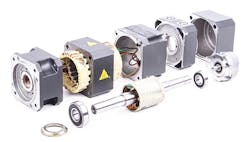Motion control trends that could shake your world
Seven motion control product manufacturers—Nippon Pulse, Hilscher North America, Aerotech, AutomationDirect, PBC Linear, Turck and Weintek USA—share their insights on customer and market trends that are driving motion-control component design, the challenges in developing and adopting new technology and the future of controllers.
Customized production
“Customers are demanding lower cost with higher performance. More personalized product runs require more flexibility at all levels of manufacturing. The need for greater efficiencies has led to the use of digital data to run and improve processes. All of these factors, along with a deficit in manpower, are fueling automation needs and the development of the smart factory,” says Beau Wileman, mechanical engineer and cobot project manager at PBC Linear.
Competitive marketplace
“All sectors of industry are ever-evolving to try to be more advanced and efficient than their competition. This starts on the component level to help aid in improving the overall process of the system,” says Kyle Horsman, product specialist at Turck. “Advancements within communications, both on a device level, as well as a plant level, have influenced the way that products have been developed. Data storage and management are equally important when ensuring that products meet the demands of an evolving marketplace.”
One to rule them all
“Users only want one network; they tolerate more because this is the state of the industry. However, the quest for one common network has not gone away, so the goal of one set of tools, one set of rules, and one cable strung around the plant has great value. Currently, we have four or five incompatible real-time clock architectures, each claiming to be the best. But the truth is that they are all good enough for almost all applications at 100 MB. This makes technologies such as TSN at least as good as what we have now. It will become even better with Gigabit Ethernet, which may allow users to achieve their goal of one wire,” says Phil Marshall, CEO of Hilscher North America.
User-friendly installation and integration
“A big factor we see in the markets is that the workplace is becoming more fluid. Employees are less likely to remain in the same role at the same company for years on end. With that market reality, motion-control solutions need to be more user-friendly than ever before. Not only does that mean better tools for configuring and programming systems, but also it means developing better APIs, so that developers can integrate your solutions into their own custom applications,” says Patrick Wheeler, product manager at Aerotech.
Market challenges for motion control
New technologies are pushing motion-control components to new levels of speed, accuracy and openness. For some, new innovations are challenging to get off the ground. Likewise, the market is still developing in new areas. While these challenges are real, motion-control manufacturers know what they’re up against and what the industry needs to move forward.
- Bridging legacy systems: Where legacy systems have been crucial to business operations, it’s very difficult to completely transfer to the latest innovations at one time. “The biggest difficulty is in finding ways of bridging legacy products and systems to the latest technologies as seamlessly as possible with the least amount of disturbance to everyday business,” says Horsman of Turck. “Many companies have relied on the system side of development to bridge legacy products to new systems. While new products will factor directly into Industry 4.0 designs, it is very important to have a balance of products that can be supported in any realm.”
- Securing industrial networks and control systems: With more open and flexible platforms and integration between components and machines, security risks will rise. “Motion is where electronics meet action; however, action that causes unexpected motion represents risk to equipment and people. So, the next influence on designs is adding security to minimize these risks. Profinet Security and EtherNet/IP CIP Security are now ready to deploy into the market,” says Marshall of Hilscher. “For the end user to have a secure control system utilizing a secure industrial network, you need to start at the embedded level of the automation device, including motors and drives. For facilities to comply with IEC 62443, users need to establish a chain of trust that starts at the device-level product and flows through to the design and manufacturing processes. That device-level product, such as a drive, must first itself be manufactured as a trusted component. Once the device, for example, a drive, is purchased and installed inside a facility, it can establish and maintain a trusted relationship between the PLC and itself.”
- Developing diverse solutions: As more manufacturers adopt industrial automation, the need for specialized components will only grow and branch into smaller markets. “The biggest challenge in motion control has been and will continue to be meeting the needs of a diverse application space. The industry can meet those challenges by bringing to market flexible platform-based motion-control solutions that not only control a variety of precision mechatronic devices, but also make that control accessible to those with complex factory-floor systems and those programming only simple motion,” says Aerotech’s Wheeler. “Motion controllers now must view themselves as being another networked device. Special considerations, such as enabling network access while controlling who has access to the controller must be taken into account. To be completely disconnected from any network is less of a reality for precision systems, so how connections and security are managed is much more important now. The use of older motion-control products might limit how a machine is integrated into a factory environment.”
- Stabilizing designs through supply chain woes: The pandemic has exposed kinks in the supply chain in almost every industry, and manufacturing has felt the crunch in electronics among other products. “Most recently, the challenge has been to find the right control chips and processors that are readily available. The global chip shortage, created by extraordinary demand, is making it difficult to stabilize designs. Which part is going to be affected next, which parts will no longer be available? Staying current on component trends and availability keeps the electronics design engineer busy,” says Bob White, technical sales manager at Nippon Pulse.
Data revolution
All the integration, customization and user-friendly components are driven by data-rich applications, bringing together information technology (IT) and operations technology (OT) to analyze performance data to improve maintenance and production and advance digital technologies for equipment and processes.
“Industry 4.0 may be perceived as a combination of conventional automation systems and information technology. A conventional motion control system lacks the information-technology piece and therefore must be designed from the beginning, or retrofitted later, with modern IT technologies to unlock the increased device efficiency; data collection and management; and system monitoring that Industry 4.0 is known for. In such a system, a high-performance integration device is required to bring multiple brands of devices or sensors together, collect data, provide remote access and manage alarms,” says Oscar Rojas, CEO of Weintek USA.
All the performance data in the world can’t affect production without proper analysis and open communication. “The Internet of Things (IoT) and Industry 4.0 are a catalyst for controller companies to find new ways to bring critical performance data to the surface and provide a means to communicate that data to other networked systems. This in turn drives improvements in predictive maintenance, reducing machine downtime,” says White of Nippon Pulse.
Motion-control products play an important role in asset management enabled by sensor data. “IIoT and Industry 4.0 represent the trend for digitalization of manufacturing equipment and processes. This promotes machine uptime and higher-quality levels in the production output. Motion-control products can play a role by providing more visibility into equipment condition with added sensors to observe anomalies and enable predictive maintenance. Another trend is the need for greater control in smaller packages, such as required in robot arms and other automated equipment that use motion. Here the integration of networking and motion becomes a benefit, enabling compact inverters and smaller controls for robot arms and similar applications,” says Marshall of Hilscher.
4 future trends for motion control design
- Integrated industrial communications: “Industrial communication is about exchanging data and information in real time. In factory automation, this is mainly done at the control and field level. Because the widespread standard Ethernet did not meet the requirements of industrial communication, real-time Ethernet, also known as industrial Ethernet, ultimately emerged from it. Different versions developed in order to meet the tough real-time requirements. Most real-time Ethernet standards require a special IP with MAC extensions to enable the communication protocols based on them to plan, prioritize and synchronize the cyclical exchange of data between the controller and the field device network,” explains Niels Trapp, vice president of business development for Hilscher Gesellschaft für Systemautomation.
“The compliance, maintenance and further development of the different real-time Ethernet protocol standards is carried out by user organizations. Market preferences—which variants are preferred—differ according to region, industry and application. With time-sensitive networking (TSN), another variant is currently entering the real-time Ethernet stage. This is a series of extensions to equip standard Ethernet under the IEEE 802.1 and IEEE 802.3 with mechanisms for the transmission of data in real time. It remains exciting to see whether the industry can agree on a quantity structure for a switch profile from this or different characteristics emerge. We are or will of course be prepared for all eventualities,” says Trapp. - Bringing IT and OT together: “The trend to integrate motion and networks and enable compact designs for motion control in a decentralized motion setup will continue. At the same time, we can expect more IT data to be extracted from the motion-control products and into edge controllers or cloud applications for higher-level applications, such as predictive maintenance or optimized material handling. Security becomes key to protect the facilities from intruders and to validate the integrity of equipment in the system. From Hilscher’s perspective, we see the need for more performance in next-generation silicon, as well as the support and enablement of cloud applications,” says Marshall of Hischer.
- Scalable and accessible products: “Over the past 30 years, motion control has been owned by the controls engineers. If you wanted to do anything serious with a motion controller, you needed to have a controls engineer on-site. However, in 10 years, the controls engineer’s knowledge and capabilities will be engineered into the product, making precision more scalable and accessible than ever. This in turn will grow the application space for precision,” says Wheeler of Aerotech.
- Flexible and optimized machines: “Continued flexibility in how the customer can use and customize the control system to take advantage of innovative and proprietary ideas that put them ahead of their competitors. Having a controller that can optimize machine performance and is the right fit, instead of letting the device dictate the performance based on its limitations,” says White of Nippon Pulse.
About the Author
Anna Townshend
Managing Editor
Anna Townshend has been a writer and journalist for 20 years. Previously, she was the editor of Marina Dock Age and International Dredging Review, until she joined Endeavor Business Media in June 2020. She is the managing editor of Control Design and Plant Services.

Leaders relevant to this article:


